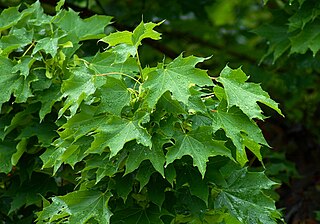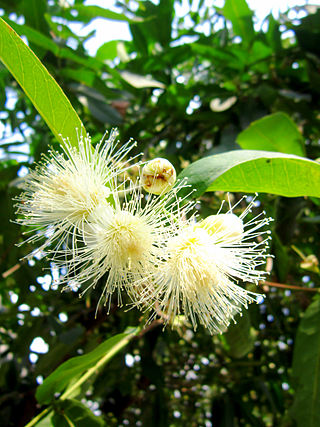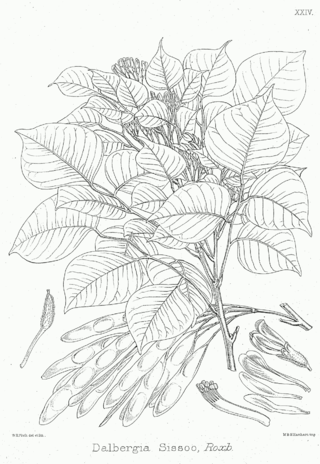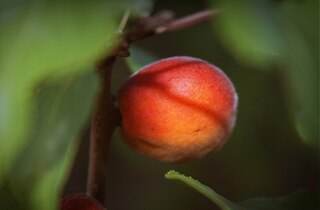
Acer platanoides, commonly known as the Norway maple, is a species of maple native to eastern and central Europe and western Asia, from Spain east to Russia, north to southern Scandinavia and southeast to northern Iran. It was introduced to North America in the mid-1700s as a shade tree. It is a member of the family Sapindaceae.

American sweetgum, also known as American storax, hazel pine, bilsted, redgum, satin-walnut, star-leaved gum, alligatorwood, or simply sweetgum, is a deciduous tree in the genus Liquidambar native to warm temperate areas of eastern North America and tropical montane regions of Mexico and Central America. Sweetgum is one of the main valuable forest trees in the southeastern United States, and is a popular ornamental tree in temperate climates. It is recognizable by the combination of its five-pointed star-shaped leaves and its hard, spiked fruits. It is currently classified in the plant family Altingiaceae, but was formerly considered a member of the Hamamelidaceae.

Syzygium samarangense is a species of flowering plant in the family Myrtaceae, native to an area that includes the Greater Sunda Islands, Malay Peninsula, and the Andaman and Nicobar Islands, but introduced in prehistoric times to a wider area and now widely cultivated in the tropics. Common names in English include wax apple, Java apple, Semarang rose-apple, and wax jambu.

Paulownia tomentosa, common names princess tree, empress tree, or foxglove-tree, is a deciduous hardwood tree in the family Paulowniaceae, native to central and western China. It is an extremely fast-growing tree with seeds that disperse readily, and is a persistent exotic invasive species in North America, where it has undergone naturalisation in large areas of the Eastern US. P. tomentosa has also been introduced to Western and Central Europe, and is establishing itself as a naturalised species there as well.

Paulownia is a genus of seven to 17 species of hardwood trees in the family Paulowniaceae, the order Lamiales. The genus and family are native to east Asia and are widespread across China. The genus, originally Pavlovnia but now usually spelled Paulownia, was named in honour of Anna Pavlovna, queen consort of The Netherlands (1795–1865), daughter of Tsar Paul I of Russia. It is also called "princess tree" for the same reason.

Tilia americana is a species of tree in the family Malvaceae, native to eastern North America, from southeast Manitoba east to New Brunswick, southwest to northeast Oklahoma, southeast to South Carolina, and west along the Niobrara River to Cherry County, Nebraska. It is the sole representative of its genus in the Western Hemisphere, assuming T. caroliniana is treated as a subspecies or local ecotype of T. americana. Common names include American basswood and American linden.

Acacia melanoxylon, commonly known as the Australian blackwood, is an Acacia species native to south-eastern Australia. The species is also known as blackwood, hickory, mudgerabah, Tasmanian blackwood, or blackwood acacia. The tree belongs to the Plurinerves section of Acacia and is one of the most wide-ranging tree species in eastern Australia and is quite variable mostly in the size and shape of the phyllodes.

Fuchsia excorticata, commonly known as tree fuchsia, New Zealand fuchsia and by its Māori name kōtukutuku, is a New Zealand native tree belonging to the family Onagraceae. It is commonly found throughout New Zealand and as far south as the Auckland Islands. It grows from sea level up to about 1,000 m (3,300 ft), particularly alongside creeks and rivers. It is easily recognised in its native environment by the characteristic appearance of its bark, which peels spontaneously, hanging in red papery strips to show a pale bark underneath. Its scientific name, excorticata, reflects this distinctive property.

Pterocarpus angolensis is a species of Pterocarpus native to southern Africa, in Angola, Mozambique, Namibia, South Africa, Eswatini, Tanzania, Democratic Republic of the Congo, Zimbabwe, and Zambia. It is a protected tree in South Africa. The name Kiaat, although Afrikaans, is sometimes used outside South Africa as well. In Zimbabwe, depending on what region you are in, it is known as Mukwa( which it is also called in Zambia) or Mubvamaropa.

Afrocarpus falcatus is a species of tree in the family Podocarpaceae. It is native to the montane forests of southern Africa, where it is distributed in Malawi, Mozambique, South Africa, and Eswatini. Common names include common yellowwood, bastard yellowwood, outeniqua yellowwood, African pine tree, weeping yew, Afrikaans: outeniekwageelhout, kalander, Sotho: mogôbagôba, Xhosa: umkhoba and Zulu: umsonti. It is widespread, in some areas abundant, and not considered threatened, but it is a protected tree in South Africa. It is grown as an ornamental tree, especially in South Africa, and occasionally abroad.

Dalbergia sissoo, known commonly as North Indian rosewood or shisham, is a fast-growing, hardy, deciduous rosewood tree native to the Indian subcontinent and southern Iran. D. sissoo is a large, crooked tree with long, leathery leaves and whitish or pink flowers.

Paulownia elongata is a species of tree in the family Paulowniaceae, native to Asia.

Paeonia ludlowii, is a deciduous shrub of medium height, belonging to the tree peony section Moutan of the genus Paeonia, and endemic to southeast Tibet. In Tibet it is known as ≠'lumaidao' meaning "God's flower". The vernacular name in Chinese is 大花黄牡丹 meaning "big yellow-flowered peony". In English it is sometimes called Tibetan tree peony or Ludlow's tree peony. It has pure yellow, slightly nodding, bowl-shaped flowers, and large, twice compounded, light green leaves.

Cinnamomum verum is a small evergreen tree belonging to the family Lauraceae, native to Sri Lanka. The inner bark of the tree is historically regarded as the 'spice' cinnamon, though this term was later generalized for both C. cassia and C. zeylanicum as well.

Acer palmatum, commonly known as Japanese maple, palmate maple, or smooth Japanese maple (Korean: danpungnamu, 단풍나무, Japanese: irohamomiji, イロハモミジ, or momiji,, is a species of woody plant native to Korea, Japan, China, eastern Mongolia, and southeast Russia. Many different cultivars of this maple have been selected and they are grown worldwide for their large variety of attractive forms, leaf shapes, and spectacular colors.

Toona sureni is a species of tree in the mahogany family. It is native to South Asia, Indochina, Malesia, China, and Papua New Guinea. It is commonly known as the suren toon, surian, limpaga, iron redwood or the red cedar. It is also known as the Indonesian mahogany or the Vietnamese mahogany. The species is a valuable timber tree.

Prunus sibirica, commonly known as Siberian apricot, is a species of shrub or small tree native to northern China, Korea, Mongolia, and eastern Siberia. It is classified in the rose family, Rosaceae, and is one of several species whose fruit are called apricot, although this species is rarely cultivated for its fruit. The species was named by Carl Linnaeus in 1753.

Trilepisium madagascariense, the urnfig or false-fig, is a species of plant in the family Moraceae, with an extensive range in the subtropical and tropical Afrotropics. It grows to a medium-sized or large tree in primary or secondary forest, or in forest patches, and is rarely cultivated.

Cola nitida is a species of plant belonging to the family Malvaceae.

Zelkova serrata is a species of the genus Zelkova native to Japan, Korea, eastern China and Taiwan. It is often grown as an ornamental tree, and used in bonsai. There are two varieties, Zelkova serrata var. serrata in Japan and mainland eastern Asia, and Zelkova serrata var. tarokoensis (Hayata) Li on Taiwan which differs from the type in its smaller leaves with less deeply cut serration on the margins.




















